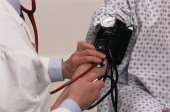Simple Steps Lead to Better Blood Pressure Control
Veterans' facility reports improvement in patients within 18 weeks.
By Ed Edelson
HealthDay Reporter
|
E-mail this article
Subscribe to news
Printer friendly version
|

(SOURCES: Christianne L. Roumie, M.D., staff physician, Veterans Affairs Tennessee Valley Healthcare System, and assistant professor, internal medicine and pediatrics, Vanderbilt University, Nashville, Tenn.; May 2, 2008, presentation, American Heart Association's annual Scientific Forum on Quality of Care and Outcomes Research in Cardiovascular Disease and Stroke, Baltimore)
FRIDAY, May 2 (HealthDay News) -- A veterans' facility made some small but significant changes in the way it was handling high blood pressure among patients and got a small but significant improvement in blood pressure control, a new study shows.
It might not sound like much -- an increase from 61.8 percent to 64.3 percent of veterans reaching the blood pressure goal below 140/90. But that gain meant that nearly 1,400 people had improved blood pressure control in a group of nearly 54,000, said study author Dr. Christianne L. Roumie, an assistant professor of medicine at Vanderbilt University and a staff physician for the Veterans Affairs Tennessee Valley Healthcare System.
Achieving that goal nationwide would be a significant improvement, since most institutions have only 30 percent to 50 percent of high blood pressure cases under control, she said.
"We were interested in improving the quality of our hypertension [high blood pressure] control and formed a committee," Roumie said. "The committee looked at the barriers to care, where the problems were, and what we could do to fix them."
Some of the changes involved the health-care providers themselves. "We improved the way the nurses were doing blood pressure so they all did it in a standardized way," Roumie said. "That prevented measurement error."
At the same time, treatment guidelines were established for staffers, with a system allowing feedback from doctors about how well they were being followed. Group practices were audited, with feedback on the success of their efforts.
"There was some patient education, so that the patients could track their own blood pressure and know what their goals were," Roumie said.
The 2.5 percent increase in blood pressure control was achieved within 18 weeks. The national impact of reaching such a goal would be significant since it's estimated that 73 million Americans have high blood pressure, a major risk factor for heart disease and stroke, Roumie said.
The findings were to be presented Friday at the American Heart Association's annual Scientific Forum on Quality of Care and Outcomes Research in Cardiovascular Disease and Stroke, in Baltimore.
Other medical centers wanting to improve their patients' blood pressure control don't need to follow the Tennessee system's approach step by step, Roumie said.
"We focused on educational activities specific for our site," she said. "This does have the potential to spread to other institutions, but each institution needs to look at the barriers in its own health system and design interventions to address those areas."
More information
Learn more about high blood pressure and controlling it from the U.S. National Library of Medicine.
Copyright © 2008 ScoutNews, LLC. All rights reserved. 
HealthDayNews articles are derived from various sources and do not reflect federal policy. healthfinder.gov does not endorse opinions, products, or services that may appear in news stories. For more information on health topics in the news, visit the healthfinder.gov health library.